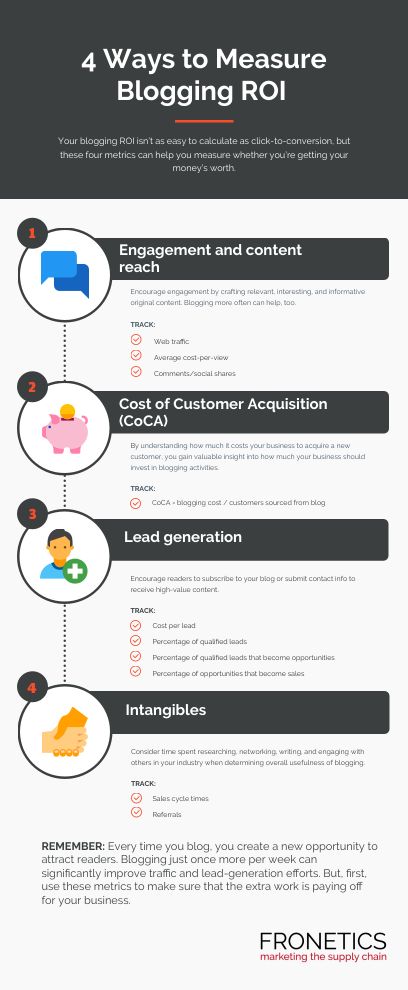
5½ Tips for Optimizing Historic Blog Content
An important part of your content strategy should be optimizing historic blog content to ensure it’s attracting as much traffic as possible.
We all know that creating original content on a regular basis is important to improving SEO and attracting organic traffic to your website. But, here’s a surprise: Most of your traffic will come from older blog posts.
An important part of your content strategy should be optimizing historic blog content to ensure it’s attracting as much traffic as possible.
If you have a lot of content, that may scare you. (Sounds like a lot of work!) But, as with everything, being strategic about optimizing historic blog content will pay off many times over. Here’s how I suggest going about that.
Pick your posts
At Fronetics, about 80% of our traffic comes from posts that are 6 months old or older. HubSpot also discovered a similar trend: 76% of its monthly views came from old posts, as well as 92% of the company’s monthly leads!
[bctt tweet=”76% of HubSpot’s monthly views come from old posts and 92% of their monthly leads.” username=”Fronetics”]
But not all posts were created equal. In fact, HubSpot found they got about half of their monthly leads from only 30 posts, and they blog at a blistering pace of about 200 new posts every month. Going back and optimizing hundreds of your old posts is a waste of time.
Hunt through your analytics and look for historical blog posts with:
- High traffic and high conversion rates: Readers view these posts often and convert frequently after reading them. Found any of these? Congrats. Most companies won’t have more than 1 or 2.
- High traffic but low conversation rates: These are the posts are viewed often but don’t generate leads.
- Low traffic but high conversion rates: These posts only garner a small number of hits but do well generating leads due to a higher-than-normal number of call-to-action click-throughs.
All set? Have a list of good blogs to work with? Here comes the fun part!
5 tips for optimizing historic blog content
Here are 5 tips to squeeze the absolute most out of your older blog posts (in terms of leads and conversions).
1. Update the content.
Rework it for today. Take out anything outdated and use a little finesse to make it more relevant. Don’t overhaul it; that’s unnecessary for a well-performing post.
2. Spice up the call-to-actions.
You’ll want to pay special attention to this for the posts that have high traffic but low conversion rates. CTAs have evolved. Old ones just aren’t going to appeal.
Revamp the CTA placement and appearance, and think (hard) again about your CTA content. Consider the language of the CTA and whether it fits the reader’s goal. What keyword(s) are they using to find the page? And does the CTA reflect this?
There’s so much information out there on making strong CTAs, but the bottom line is the CTA must match the intent of the audience.
Keep it bold. Keep it clear. And make ‘em an offer they can’t refuse.
3. Relook at your keywords.
For the posts that do well converting leads but don’t get a lot of traffic, you’ll need to take a fresh look at keywords.
Trying to rank for certain keywords in each blog post you publish is a practice on the way out. But it still has merit here, as long as you understand it within the larger picture of restructuring your website content into topic clusters and pillar content.
People are changing how they search, and search-engine-optimizing these old posts to get more visibility is the goal.
And here’s the beauty of optimizing historical blog content: You already have the data to know which keywords your audience are using to find the posts. Then prominently feature the keyword(s) in several places.
- Blog post title
- URL slug (e.g., fronetics.com/3-quick-seo-tips-improve-blog-right-now)
- Headings
- The first sentence of your post
- Several times throughout the body of the post
- The post’s meta description
- The image’s alt text
4. Update your posts’ meta descriptions.
If you’ve done the hard work to update the CTA and the keywords, updating the meta description is a natural next step. Keep it as close to (but not over) 155-165 characters. Include your keyword(s). Explain the value of the post to the reader. And keep in mind your ultimate CTA goal. Everything should align to make the meta description a true synthesis of the post; if it doesn’t, go back and tweak a little more.
5. Republish and keep the URL.
Things that are “fresh” receive preferential treatment from Google. (We know it’s hard to believe when 2012 articles are at the top of your search results, but it’s true.)
But do not lose that original URL when you publish again. It pulls way more SEO “rank” than a new one. Keep the URL even if you updated the title of the post and the URL doesn’t match perfectly anymore. It’s OK.
(It’s not a bad idea to put in an editor’s note at the end of the article if the blog already has garnered comments, so your future audience won’t be confused by a publish date that is later than the date on the comments.)
And that’s it. 30 days after optimizing your historic blog content, go back and see how successful your efforts were. Track the metrics: post views, CTA click-throughs, lead generation, and keyword ranking. We’re betting they’ve gone up.
Measuring the success of your SEO strategy shouldn’t be done by measuring the success of one post at a time. But making the most of your best old posts is an important part of any good content marketing strategy.
Final tip
The final tip isn’t really about optimizing historic blog content, so let’s call it a ½ tip. Remember how Tip 1 recommended reworking the old posts but warned against overhauling them with large rewrites?
Well… Here’s the thing. If you have 12 historic blog posts you just optimized, you should write 12 new blog posts on that same content, too.
Recycle that good historic content into additional fresh content. After all, it’s what your audience is searching for!
Related posts:





